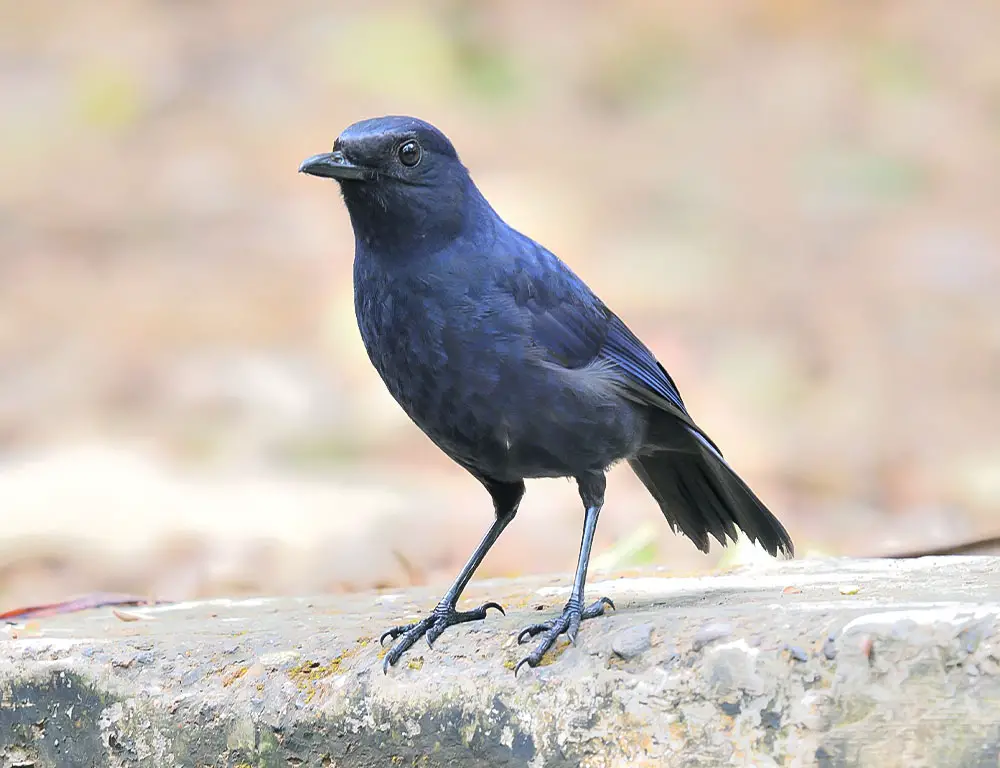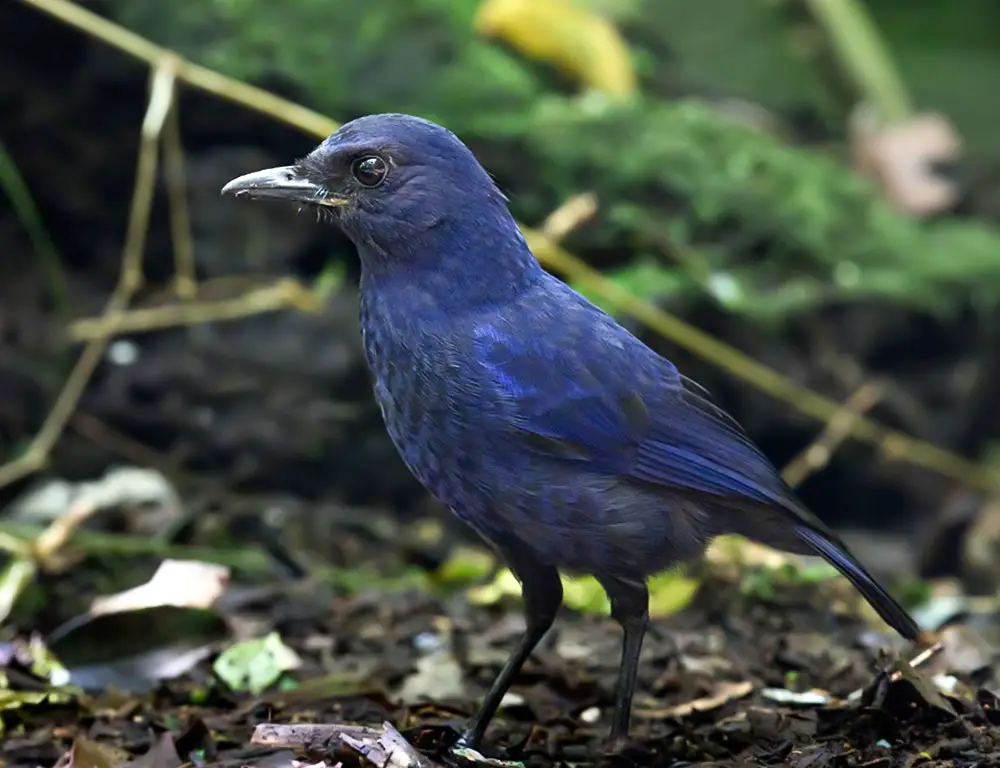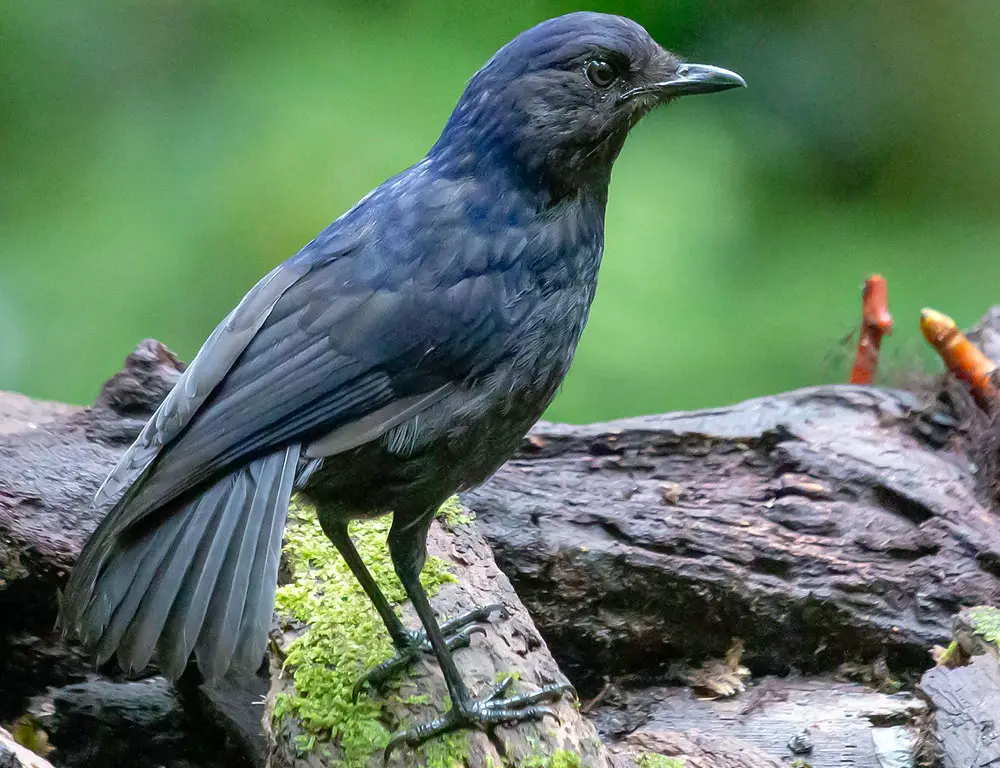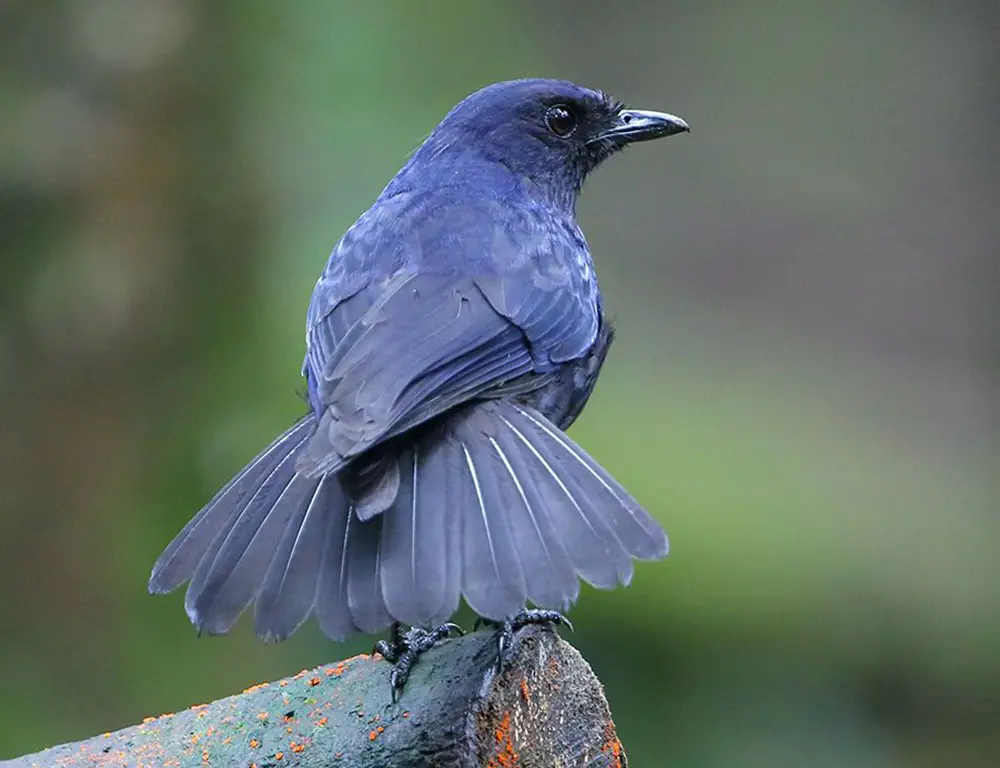The Javan Whistling Thrush (Myophonus glaucinus) stands as a captivating symbol of the montane forests of Java and Bali, Indonesia.
Adorned in striking dark blue plumage with iridescent hues, this enigmatic bird enchants observers with its melodious whistle echoing through the dense foliage.
Endemic to the Indonesian archipelago, its presence adds vibrancy to the high-altitude forests, where it forages amidst the leaf litter and rocky outcrops.
As an insectivorous species, it plays a crucial role in maintaining ecological balance by regulating insect populations.
Despite its allure, the Javan Whistling Thrush faces conservation challenges due to habitat loss and degradation. Understanding and protecting this species is essential for preserving the biodiversity of its montane habitat.
Physical Characteristics of the Javan Whistling Thrush

The Javan Whistling Thrush (Myophonus glaucinus) possesses distinctive physical characteristics contributing to its unique appearance and ecological niche.
Here’s a breakdown of its fundamental physical traits:
Plumage
The Javan Whistling Thrush is renowned for its stunning plumage, predominantly dark blue or bluish-black. This rich coloration covers most of its body, giving it a mysterious and elegant appearance.
Males typically exhibit more vibrant colors than females, with brighter blues and iridescence on the wings and tail.
Size and Shape
This thrush is relatively compact, measuring around 23-25 centimeters (9-10 inches) in length from beak to tail. It has a rounded body shape with a robust build suitable for navigating through the dense vegetation of its montane forest habitat.
Beak
The Javan Whistling Thrush has a short and stout beak, which is well-adapted for capturing its prey. Its beak is dark in color, blending seamlessly with its plumage. This bird primarily feeds on insects, spiders, and snails in its forest environment.
Eyes
Dark and expressive, the eyes of the Javan Whistling Thrush provide excellent vision for detecting movement and locating prey. Their sharp eyesight is crucial for foraging efficiently in the dimly lit forest understory.
Tail
While relatively short, the tail of the Javan Whistling Thrush is well-proportioned to its body size. It plays a vital role in balance and maneuverability during flight and perching. The tail feathers are neatly arranged, contributing to the bird’s agility.
Weight
The average weight of the Javan Whistling Thrush ranges between 70 to 100 grams (2.5 to 3.5 ounces). Despite its lightweight, it is resilient and well-suited for its forest habitat.
Sexual Dimorphism
While both males and females share similar plumage patterns, males often exhibit more intense coloration, especially during breeding. This slight difference in appearance helps distinguish between the sexes.
Habitat and Distribution of Javan Whistling Thrush

The Javan Whistling Thrush (Myophonus glaucinus) is primarily found in the montane forests of Java and Bali, Indonesia.
Here’s a detailed overview of its habitat and distribution:
Habitat
- Montane Forests: The Javan Whistling Thrush inhabits montane forests characterized by their high altitude and dense vegetation. These forests typically occur at elevations ranging from 800 to 2400 meters above sea level. The bird favors areas with ample cover, including thick undergrowth, rocky outcrops, and forest edges.
- Preferential Areas: Within its montane habitat, the Javan Whistling Thrush often gravitates towards rocky outcrops and areas near water sources, such as streams or rivers. These locations provide suitable foraging grounds and nesting sites.
- Human Proximity: Interestingly, the Javan Whistling Thrush can sometimes be found in areas frequented by humans, such as gardens or parks near forested regions. Despite its shy nature, it may be tame in these environments.
Distribution
- Endemic to Java and Bali: The Javan Whistling Thrush is endemic to the Indonesian islands of Java and Bali. It is primarily distributed across these islands, with populations scattered throughout suitable montane forest habitats.
- Elevation Range: While the bird is primarily found at elevations between 800 to 2400 meters above sea level, its distribution may vary based on habitat availability and environmental conditions.
- Geographic Range: On Java, the Javan Whistling Thrush can be encountered from west to east, spanning various montane forest regions. In Bali, its distribution is more limited, primarily occurring within suitable habitats in the western part of the island.
Diet and Feeding Habits of Javan Whistling Thrush

The Javan Whistling Thrush (Myophonus glaucinus) is an insectivorous bird species with specialized feeding habits suited to its forest habitat.
Here’s a detailed overview of its diet and feeding behavior:
Diet
- Insects: The primary component of the Javan Whistling Thrush’s diet consists of various insects and their larvae. It feeds on many insect species, including beetles, ants, termites, grasshoppers, caterpillars, and moths. These insects are abundant in the forest understory, providing a readily available food source for the thrush.
- Spiders: Besides insects, the Javan Whistling Thrush also prey on spiders. Spiders are an essential part of its diet, and the bird may actively search for them among the foliage or on the forest floor.
- Snails: While less common compared to insects and spiders, snails are occasionally consumed by the Javan Whistling Thrush. Snails provide additional protein and nutrients, supplementing the bird’s diet when other prey items are scarce.
- Fruits and Berries: Although not a primary component of its diet, the Javan Whistling Thrush may consume small fruits and berries when available. It may opportunistically feed on ripe fruits in its forest habitat, especially during fruiting seasons.
Feeding Habits
- Foraging Behavior: The Javan Whistling Thrush is primarily a ground-foraging bird, searching for food amidst the leaf litter and undergrowth of the forest floor. It employs a combination of visual and auditory cues to locate prey, using its keen eyesight and acute hearing to detect movement and sound.
- Hunting Technique: When hunting for insects and other prey, the thrush adopts a stealthy approach, carefully scanning the forest floor and vegetation for potential targets. It may hop or stroll while searching for prey, occasionally pausing to listen for the sounds of insects or rustling foliage.
- Pouncing and Probing: Once it detects prey, the Javan Whistling Thrush employs a quick pouncing or probing motion to capture its target. It may use its sharp beak to snatch insects from the ground or vegetation or probe crevices and leaf litter in search of hidden prey such as spiders or snails.
- Territoriality: The Javan Whistling Thrush is territorial when feeding and defending its foraging territory against intruders or competitors. It may vocalize loudly or aggressively to deter rivals from infringing on its feeding grounds.
Conservation Status of Javan Whistling Thrush

The conservation status of the Javan Whistling Thrush (Myophonus glaucinus) is of growing concern due to various threats to its habitat and population.
Here’s an overview of its conservation status:
IUCN Red List Status
The Javan Whistling Thrush is classified as “Near Threatened” on the International Union for Conservation of Nature (IUCN) Red List. This designation indicates that the species risk becoming endangered if ineffective conservation efforts are implemented.
Habitat Loss and Degradation
One of the primary threats to the Javan Whistling Thrush is habitat loss and degradation. Rapid urbanization, deforestation, agricultural expansion, and infrastructure development have resulted in the loss and fragmentation of its montane forest habitat.
These activities reduce the habitat for the thrush, disrupt vital ecological processes, and diminish biodiversity.
Illegal Hunting and Trade
The Javan Whistling Thrush is also threatened by illegal hunting and trade, where individuals may be captured for the pet trade or killed for various purposes.
Unregulated hunting and poaching can harm local populations, leading to declines in numbers and genetic diversity.
Climate Change
Climate change poses additional challenges to conserving the Javan Whistling Thrush and its habitat. Shifts in temperature and precipitation patterns and altered habitat suitability may impact the bird’s distribution, reproductive success, and food availability.
Conservation Efforts
Despite these challenges, efforts are underway to conserve the Javan Whistling Thrush and its montane forest habitat. Conservation organizations, government agencies, and local communities are implementing various strategies, including:
- We are establishing protected areas and wildlife reserves to safeguard critical habitats.
- We are implementing sustainable forestry practices to mitigate habitat loss and degradation.
- We are conducting research and monitoring better to understand the thrush’s ecology and population dynamics.
- You are engaging in community-based conservation initiatives to raise awareness and foster local stewardship of natural resources.
- We are strengthening law enforcement measures to combat illegal hunting, poaching, and trade of the species.
Public Awareness and Education
Increasing public awareness about the importance of biodiversity conservation and the threats facing the Javan Whistling Thrush is essential for garnering support for conservation efforts.
Education and outreach programs empower communities to participate in conservation activities and advocate for protecting the species and its habitat.
FAQs
What predators does the Javan Whistling Thrush face?
The Javan Whistling Thrush may face predation from predators, including snakes, birds of prey such as owls and hawks, and mammals like civets and monitor lizards. Its cryptic plumage and elusive behavior help minimize the risk of predation.
How does the Javan Whistling Thrush build its nest?
The Javan Whistling Thrush constructs its nest using twigs, leaves, moss, and grass. Nests are typically built in concealed locations, such as rock crevices, tree branches, or on the ground under dense vegetation.
How many eggs does the Javan Whistling Thrush lay?
The Javan Whistling Thrush typically lays two eggs per nesting period. Both male and female thrushes incubate the eggs and care for the chicks after hatching.
Does the Javan Whistling Thrush migrate?
The Javan Whistling Thrush is not considered a migratory bird. It primarily resides year-round in its montane forest habitat in Java and Bali. However, local movements may occur in response to seasonal changes or resource availability.
Can the Javan Whistling Thrush be kept as a pet?
Keeping the Javan Whistling Thrush as a pet is illegal and unethical. Conservation laws prohibit the capture and trade of wild birds, and efforts should focus on preserving them in their natural habitat.
Conclusion
The Javan Whistling Thrush (Myophonus glaucinus) emerges as a captivating emblem of the montane forests of Java and Bali, offering a glimpse into the rich biodiversity of these tropical ecosystems.
With its striking plumage and enchanting whistle, this species adds a touch of allure to its habitat, captivating birdwatchers and nature enthusiasts alike.
However, its existence is increasingly threatened by habitat loss, illegal hunting, and other human-induced pressures.
As stewards of our natural world, we must prioritize conservation efforts to safeguard the Javan Whistling Thrush and its habitat.
By fostering awareness, implementing sustainable practices, and engaging in proactive conservation initiatives, we can ensure the continued survival of this remarkable bird species, preserving its legacy for future generations to appreciate and cherish.